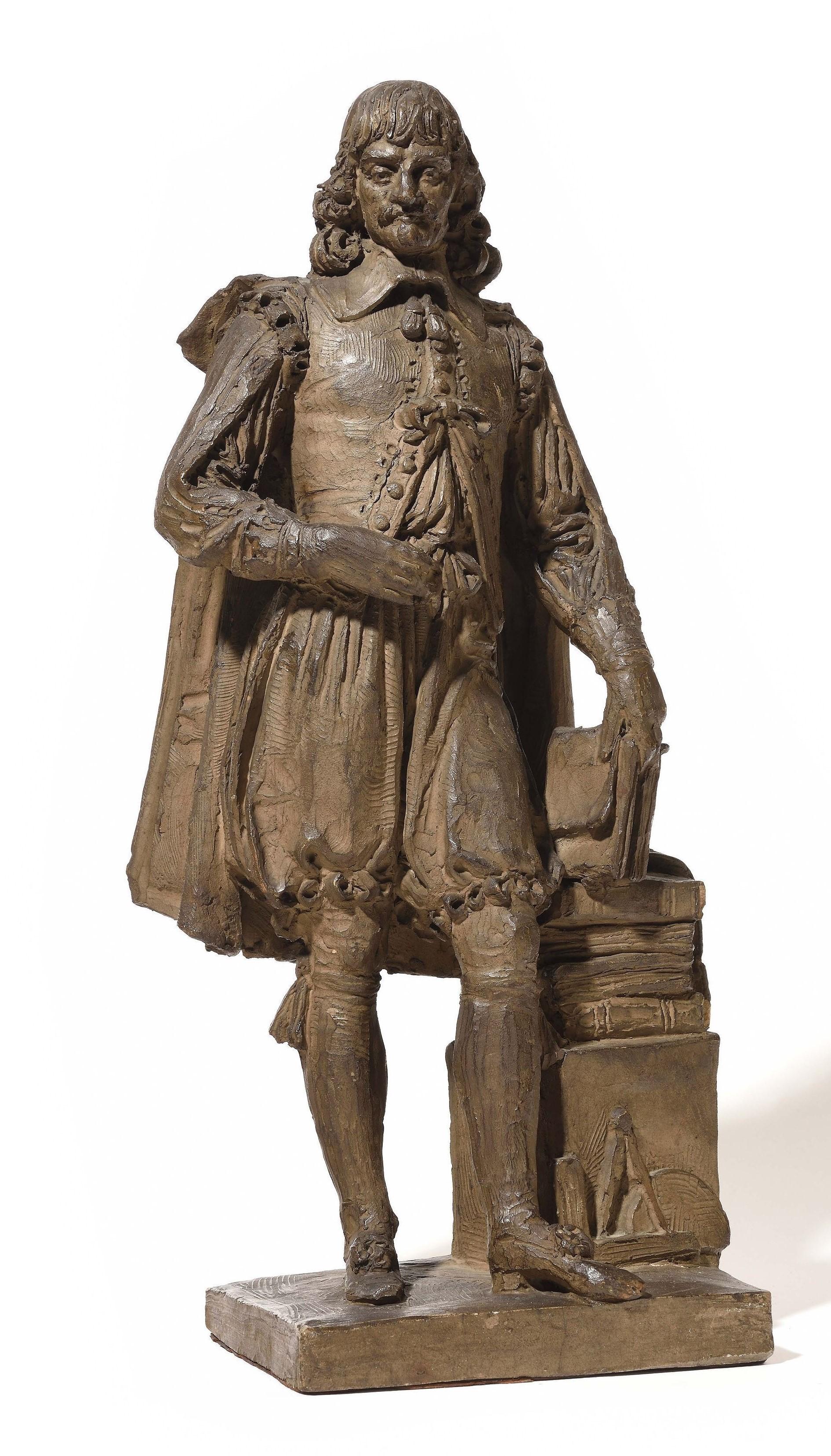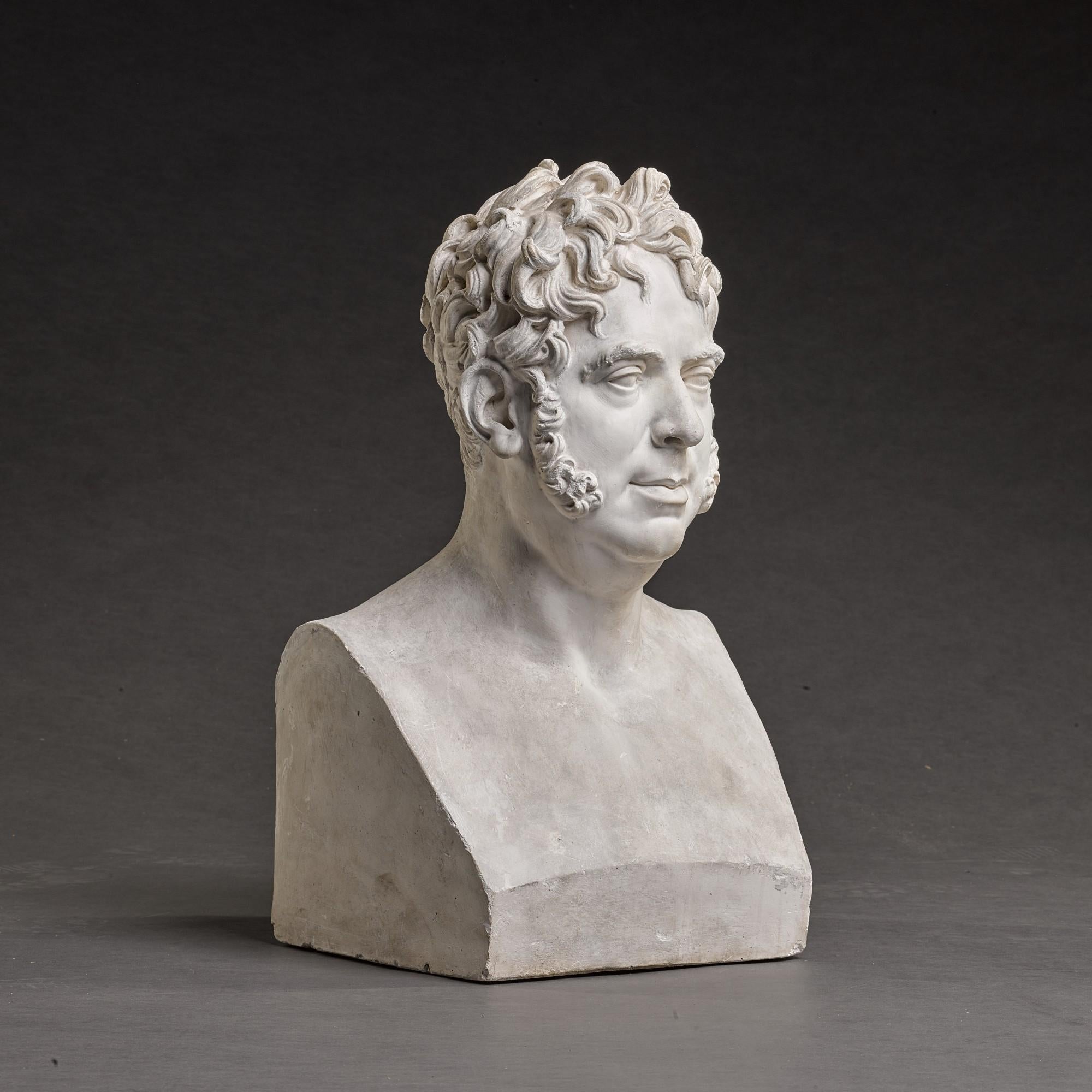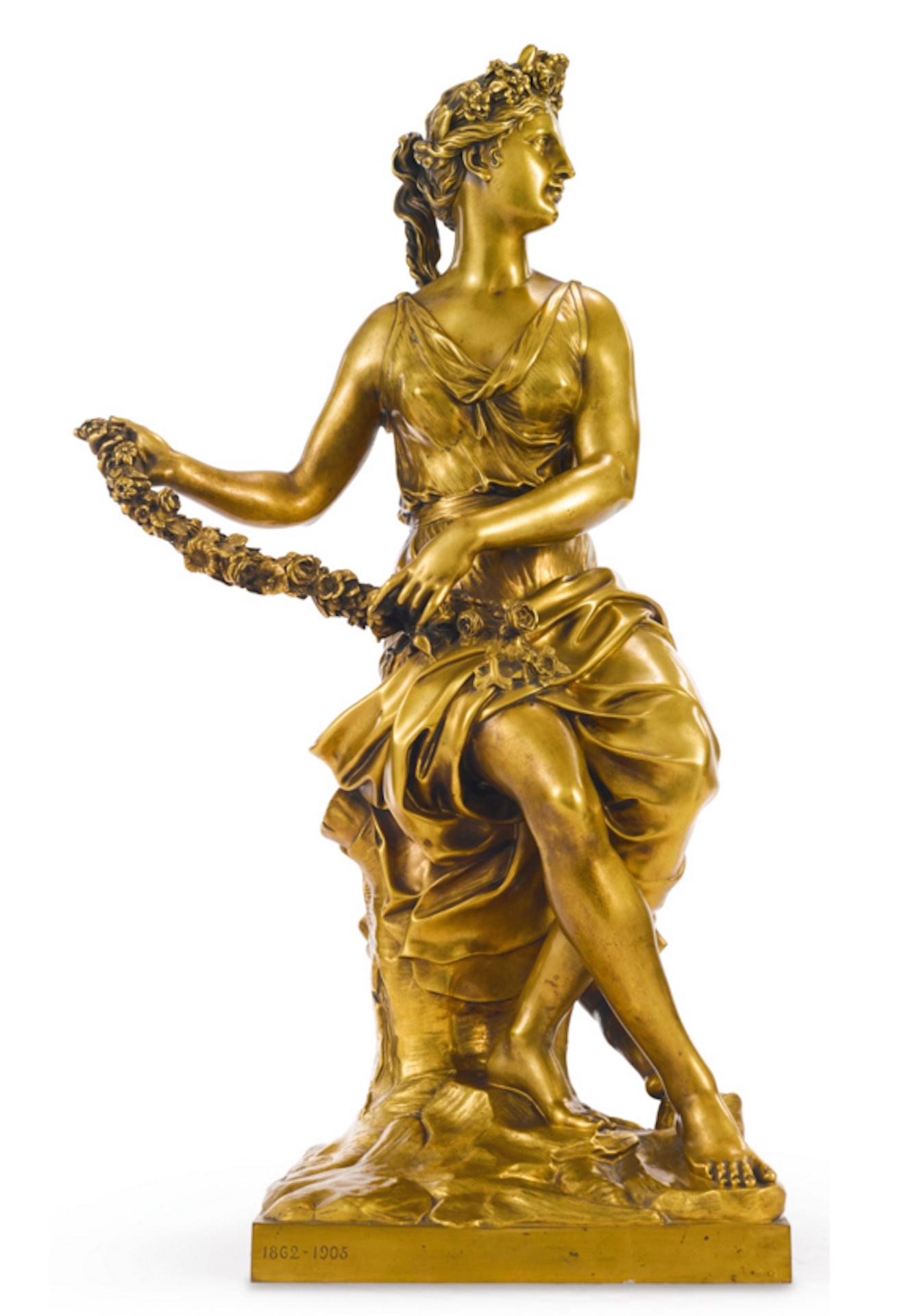Items Similar to Young woman wearing a shawl
Want more images or videos?
Request additional images or videos from the seller
1 of 14
Albert-Ernest Carrier-BelleuseYoung woman wearing a shawlcirca 1860
circa 1860
About the Item
Bust of a young woman wearing a shawl
by Albert-Ernest Carrier-Belleuse (1824-1887)
Terracotta bust
Raised on a in blackened wood pedestal
signed "A. Carrier "
France
circa 1860
total height 41 cm
width 24 cm
depth 17 cm
Biography :
Albert-Ernest Carrier de Belleuse known as Carrier-Belleuse (1824-1887) was one of the most prolific artists of the century and had the greatest successes under the Second Empire, enjoying the personal support of Napoleon III. His work was greatly influenced by the style of the Italian Renaissance and that of the 18th century, which he helped to bring up to date.
In 1837, the young Carrier-Belleuse apprenticed in the workshop of the engraver Bauchery. He was admitted soon after to the goldsmith Jacques Henri Fauconnier. Through François Arago, he met the sculptor David d'Angers who facilitated his admission to the School of Fine Arts. Carrier-Belleuse entered it in 1840. Noted for his skill by the great bronze companies in Paris such as Barbedienne and Denière, he soon received numerous orders for models for candelabras, pendulums, fittings for fireplaces, etc. In 1848, probably at the initiative of François Arago, who became head of state, he received his first public order for a small statue of "Mademoiselle Rachel singing La Marseillaise". In 1851, he appeared for the first time at the Salon of French Artists, where he presented two bronze medallions. From 1851 to 1855, Carrier-Belleuse stayed in England, in Stoke-on-Trent where he served as director of the modeling and drawing school of the Minton house, a large porcelain manufacturer.
Back in France, Carrier-Belleuse moved to Paris in a large workshop located 15 rue de la Tour d´Auvergne. From 1857, he made regular sendings to the Salon and became famous thanks to the success of large marbles, such as the "Bacchante" exhibited at the Salon in 1863, and acquired by Napoleon III, "Angelica" (1866) or even "Hebe asleep" (1869). At the Salon of 1867, his group entitled "Messiah" earned him the medal of honor of sculpture. It was acquired by the State to adorn the Chapel of the Virgin in the Saint-Vincent-de-Paul church.
Carrier-Belleuse acquired a great reputation in parallel for his terracotta busts which, in many respects, recall those of 18th century artists. He made portraits of a large number of celebrities of his time. He produced, among others, the busts of Napoleon III, Renan, Thiers, Grévy, Arago, Marguerite Bellanger, Théophile Gautier, Honoré Daumier, Delacroix, Hortense Schneider, Réjane… He also modelled numerous busts of mythological inspiration and historical and artistic portraits like Marie Stuart, Shakespeare or even Mozart.
Carrier-Belleuse used and trained in his workshop in the rue de la Tour d´Auvergne many young talented artists such as Alexandre Falguière, Jules Desbois, Eugène Delaplanche, Jules Dalou or Joseph Chéret; but he was best known for having been the master of Auguste Rodin who entered his studio as a practitioner in 1864.
Carrier-Belleuse devoted himself a lot to decorative sculpture. He contributed to the decorations of many important buildings. We owe him in particular the caryatids of the Renaissance theater in Paris, the pediment of the main entrance to the Banque de France, the stucco ceilings of the Lesdiguières and La Trémoïlle pavilions at the Louvre Palace, the frieze of the Palais de la Bourse in Brussels, or the decoration of the Hôtel de la Païva on the Champs-Elysées in Paris. He also received State commissions for monuments: that of Jean-Jacques Rousseau in Montmorency, of Alexandre Dumas, in Villers-Cotterêts, of Masséna in Nice. Abroad, he produced the equestrian statue of Michael the brave in Bucharest and the tomb of José de San Martín in Buenos Aires.
In 1873, Carrier-Belleuse took part in the construction of the Paris Opera house, directed by his friend Charles Garnier. He created the two monumental torchieres flanking the grand staircase in the main hall and the caryatids of the chimney of the grand foyer. In 1875, he was appointed director of works of art at the Porcelain Manufacture de Sèvres. He imprinted on it a very modern impulse which manifested itself in the creation of a complete range of vases.
- Creator:Albert-Ernest Carrier-Belleuse (1824 - 1887, French)
- Creation Year:circa 1860
- Dimensions:Height: 16.15 in (41 cm)Width: 9.45 in (24 cm)Depth: 6.7 in (17 cm)
- Medium:
- Movement & Style:
- Period:
- Condition:
- Gallery Location:PARIS, FR
- Reference Number:

About the Seller
5.0
Vetted Seller
These experienced sellers undergo a comprehensive evaluation by our team of in-house experts.
Established in 1992
1stDibs seller since 2023
Typical response time: 1 to 2 days
- ShippingRetrieving quote...Ships From: PARIS, France
- Return PolicyA return for this item may be initiated within 3 days of delivery.
More From This SellerView All
- Suzanne SurpriseLocated in PARIS, FR"Suzanne Surprise" by Jean-Baptiste Carpeaux (1827-1875) Terra cotta "Propriété Carpeaux" Marked with the stamp ‘Propriété Carpeaux’ with the Imperial Eagle and the stamp 'Atelier ...Category
1870s French School Figurative Sculptures
MaterialsTerracotta
- ParrotletLocated in PARIS, FRParrotlet by Armand PETERSEN (1891-1969) & SEVRES Manufacture Sculpture in white paste porcelain Signed « A. Petersen » Old edition artwork. Stamped by the porcelain manufacture of ...Category
1930s French School Figurative Sculptures
MaterialsPorcelain
- Hay PickerBy Aimé-Jules DalouLocated in PARIS, FRThis Peasant resting is a subject that is included in the famous suite commonly called "little workers" by Jules Dalou (1838-1902) Bronze with nuanced dark brown patina cast by Susse Frères - stamped with the founder's seal France created around 1890 and cast after his death height 12,5 cm A similar model reproduced inJules Dalou, le sculpteur de la République, Exhibition held at the Musée du Petit Palais, Paris, 2013, page 288, n°220. Biography : Aimé-Jules Dalou, said Jules Dalou (1838-1902) was a French sculptor, born from Protestants glovers craftsmen who raised in secularism and love of the Republic. Jules Dalou was very young talented for modeling and drawing, which earned him the attention of Jean-Baptiste Carpeaux, who made him entered in 1852 in the Little School, the future National School of Decorative Arts in Paris. In 1854, he was admitted to the School of Fine Arts in Paris, where he studied painting in the workshop of Abel de Pujol and sculpture in the workshop of Francisque Duret...Category
Late 19th Century French School Figurative Sculptures
MaterialsBronze
- Hay BalerBy Aimé-Jules DalouLocated in PARIS, FRThis Hay baler is a subject that is included in the famous suite commonly called "little workers" by Jules Dalou (1838-1902) Bronze with dark brown patina c...Category
Late 19th Century French School Figurative Sculptures
MaterialsBronze
- Bearer of wheat sheavesBy Aimé-Jules DalouLocated in PARIS, FRThis bearer of sheave is a subject that is included in the famous suite commonly called "little workers" by Jules Dalou (1838-1902) Bronze with dark brown patina cast by Susse Frère...Category
Late 19th Century French School Figurative Sculptures
MaterialsBronze
- Roman driver on his chariotBy Emmanuel FremietLocated in PARIS, FREquestrian sculpture "Roman driver on his chariot" by Emmanuel Fremiet (1824-1910) Bronze with its original nuanced dark brown patina cast by MORE France circa 1880 height 41,5 cm l...Category
1880s French School Figurative Sculptures
MaterialsBronze
You May Also Like
- L'AiglonBy Louis OuryLocated in Paris, FRLouis Oury (1867 - 1940) L’Aiglon, 1899 Terracotta with polychromatic patina Signed on the shoulder and Seal from Goldscheider on the reverse Dimensions : 65 x 40 x 30 cm (25 x 15 3/...Category
19th Century French School Figurative Sculptures
MaterialsTerracotta
- Dominique Mahlknecht (1793-1876) The french philosopher René DescartesLocated in BELEYMAS, FRDominique (Johann Dominik) MAHLKNECHT (Kastelruth, 1793 - Paris, 1876) Full length portrait of René Descartes Terracotta with brown patina Height: 40cm ...Category
1840s French School Figurative Sculptures
MaterialsPlaster
- General Cambronne bust in "Hermès" - Att. to E-E Suc (1802-1855)Located in BELEYMAS, FRAttributed to Etienne-Édouard SUC (Lorient, 1802 – Nantes, 1855) Bust "in Hermès" of General Cambronne Plaster H. 59 cm 1842 Provenance: probably Madame Cambronne (1773-1854), widow...Category
1840s French School Figurative Sculptures
MaterialsPlaster
- Flora et L'amour ou HamadryadeBy Ferdinand BarbedienneLocated in Tallinn, EEFerdinand Barbedienne (1810 - 1892) Antoine Coysevox, after (France, 1640-1720) Flora et L'amour ou Hamadryade Inscribed 'A. COYSEVOX. F. 1710'. With foundry mark 'F. BARBEDIENNE...Category
Late 19th Century French School Figurative Sculptures
MaterialsBronze
- A Basset HoundBy Jules MoigniezLocated in New York, NYinscribed J. Moigniez bronze with brown patina, cast during the artist’s lifetime height 18 1⁄2 inches (47 cm.), width 29 1⁄8 inches (74 cm.) PROVENANCE James Graham & Sons, Inc., N...Category
Late 19th Century French School Figurative Sculptures
MaterialsBronze
- Antique Silvered Bronze Rooster, France circa 19th CenturyLocated in SANTA FE, NMAntique Silvered Bronze Rooster France, circa 1900 10 1/4 x 9 1/2 (H x D) inches A very fine and lively bronze statuette of a preening Rooster. Nicely cast and well-carved and in ex...Category
19th Century French School Figurative Sculptures
MaterialsSilver, Bronze



